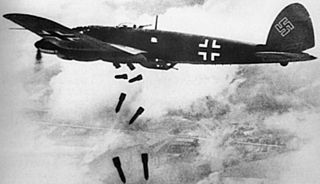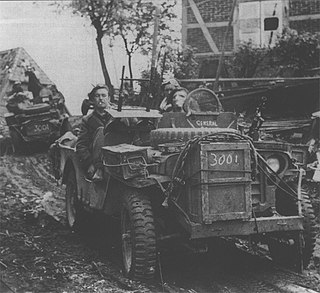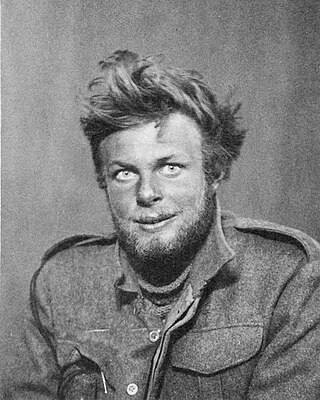
The Junkers Ju 87, popularly known as the "Stuka", is a German dive bomber and ground-attack aircraft. Designed by Hermann Pohlmann, it first flew in 1935. The Ju 87 made its combat debut in 1937 with the Luftwaffe's Condor Legion during the Spanish Civil War of 1936–1939 and served the Axis in World War II from beginning to end (1939–1945).

Sir Archibald David Stirling was a British officer in the British Army and the founder and creator of the Special Air Service (SAS). Under his leadership, the SAS carried out hit-and-run raids behind the Axis lines of the North African campaign. He saw active service during the Second World War until he was captured in January 1943. He spent the rest of the war in captivity, despite making several attempts to escape.

The Battle of Britain was a military campaign of the Second World War, in which the Royal Air Force (RAF) and the Fleet Air Arm (FAA) of the Royal Navy defended the United Kingdom (UK) against large-scale attacks by Nazi Germany's air force, the Luftwaffe. It was the first major military campaign fought entirely by air forces. The British officially recognise the battle's duration as being from 10 July until 31 October 1940, which overlaps the period of large-scale night attacks known as the Blitz, that lasted from 7 September 1940 to 11 May 1941. German historians do not follow this subdivision and regard the battle as a single campaign lasting from July 1940 to May 1941, including the Blitz.
The Royal Italian Air Force (RAI) was the name of the air force of the Kingdom of Italy. It was established as a service independent of the Royal Italian Army from 1923 until 1946. In 1946, the monarchy was abolished and the Kingdom of Italy became the Italian Republic, whereupon the name of the air force changed to Aeronautica Militare.

Operation Agreement was a ground and amphibious operation carried out by British, Rhodesian and New Zealand forces on Axis-held Tobruk from 13 to 14 September 1942, during the Second World War. A Special Interrogation Group party, fluent in German, took part in missions behind enemy lines. Diversionary actions extended to Benghazi, Jalo oasis and Barce. The Tobruk raid was an Allied disaster; the British lost several hundred men killed and captured, one cruiser, two destroyers, six motor torpedo boats and dozens of small amphibious craft.
This is a list of aviation-related events from 1941:
This is a list of aviation-related events from 1942:

Robert Blair Mayne,, better known as Paddy Mayne, was a British Army officer from Newtownards, capped for Ireland and the British and Irish Lions at rugby union, lawyer, amateur boxer, and a founding member of the Special Air Service (SAS).

Operation Flax was an Allied air operation during the Tunisian campaign, as part of the larger North African campaign of the Second World War. Flax was intended to prevent air supply between Italy and the Axis armies in Tunis, Tunisia, in April 1943. An equivalent Allied naval effort was called Operation Retribution.

The Air Force of the Independent State of Croatia, was the air force of the Independent State of Croatia (NDH), a puppet state established with the support of the Axis Powers on the territory of the Kingdom of Yugoslavia during World War II. The ZNDH was founded under German authority in April 1941, following the German-led Axis invasion of Yugoslavia.
During the Second World War the German Luftwaffe was the main support weapon of the German Army (Heer). It fought and supported the Wehrmacht's war effort throughout the six years of conflict and contributed to much of Nazi Germany's early successes in 1939–1942. After the turn in Germany's fortunes, it continued to support the German ground forces until the German surrender in May 1945.

Operation Albumen was the name given to British Commando raids in June 1942 on German airfields in the Axis-occupied Greek island of Crete, to prevent them from being used in support of the Axis forces in the Western Desert Campaign in the Second World War. The operations were carried out with similar raids against Axis airfields at Benghazi, Derna and Barce in Libya and were among the first planned sabotage acts in occupied Europe.
Sidi Haneish Airfield is an abandoned World War II military airfield complex in Egypt, in the western desert, about 376 km west-northwest of Cairo.
Operation Bigamya.k.a. Operation Snowdrop was a raid during the Second World War by the Special Air Service in September 1942 under the command of Lieutenant Colonel David Stirling and supported by the Long Range Desert Group. The plan was to destroy the harbour and storage facilities at Benghazi and raid the airfield at Benina in Libya in coordination with the RAF. The raid was part of a deception plan for Operation Agreement, the much larger raid on Tobruk.

Operation Anglo was a British Commando raid on the island of Rhodes during the Second World War. The raid was carried out by eight men of the Special Boat Section (SBS) assisted by four Greeks.
Lieutenant John Steel "Jock" Lewes was a British Army officer prominent during the Second World War. He was the founding principal training officer of the Special Air Service. Its founding commander, David Stirling, said later of Lewes, "Jock could far more genuinely claim to be founder of the SAS than I." Lewes also invented an explosive device for use by the SAS, the eponymous Lewes bomb.

Sonderkommando Blaich was a German unit consisting of a Heinkel He 111H medium bomber supported by an Italian Savoia-Marchetti SM.82 transport aircraft and a Messerschmitt Bf 108B. In January 1942 the Heinkel raided the Free French–controlled Fort Lamy in the Chad region of French Equatorial Africa. The raid against a target 1,250 mi (2,010 km) from Axis bases in North Africa was a success but on its return flight the Heinkel ran out of fuel and had to make an emergency landing; the crew and aircraft were rescued a week later.
André Louis Arthur Zirnheld was a French paratrooper, a member of the Free French Air Force, and a member of the French Squadron, Special Air Service during World War II. He is famous for being the first French paratrooper officer killed in action, and is presumed to be the author of the poem "The Paratrooper's Prayer".

Operations Wallace and Hardy I were two British Special Air Service operations during the Second World War that took place from 27 July to 19 September 1944. Initially two sets of operations by 2nd Special Air Service, they were eventually amalgamated into one. Their objective was to disrupt German lines of communication, coordinate the activities of the French Resistance and prevent German reinforcements moving to the Normandy beachheads.

Willis Michael Sadler was a British Army officer. He was the last original member of the Special Air Service and the last survivor of the Long Range Desert Group.












